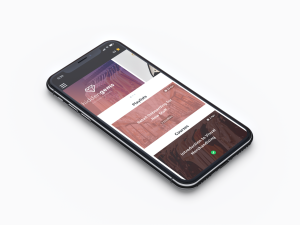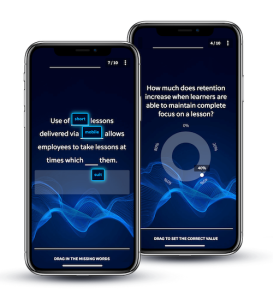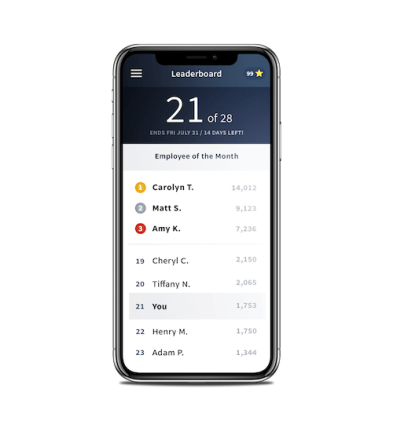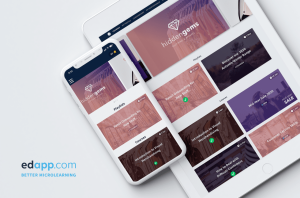How The Instructional Strategies Are Appropriate For Achieving Established Learning Goals?
Technological advances over the contempo years have led to the evolution of various types of instructional instruction strategies. When put into do, these strategies can also help learners retain knowledge more hands, reach their learning goals, and get more engaged with the learning process. To help L&D professionals guide their learners towards success and ensure that the learning experience is both interactive and constructive, we've provided a list of instructional strategies examples below.
1 – Microlearning
Microlearning is the practice of breaking complex data down into easily-digestible, bite-sized chunks. With human brusque-term memory but able to hold a maximum of three-to-five pieces of new information before information technology is overwritten or pushed out, there's a far greater likelihood of knowledge passing to long term memory if only a few, highly-targeted, topics are focused on.

2 – Spaced Repetition
Spaced repetition, or distributed practice, is the process of repeating lessons at increasing intervals until knowledge is embedded. It'due south important to apply the correct spaced repetition schedule to maximise effectiveness lest cognition is revised before information technology has had a modify to decay or after it has already rust-covered. Microlearning as an instructional model design is an enabler considering brusque lessons are more than practical to repeat. However, implementations such every bit Brain Boost are even more effective as they call back which answers a learner got right and focus primarily on those they got wrong. It'due south 1 of the most constructive instructional strategies.

three – Interactivity
When learning doesn't feel like learning, information technology's at its most effective. It needs to exist more than but answering multiple pick questions in an eLearning class just creating such interactivity is a simple instructional strategy thanks to templates: you simply add your own questions and answers.
4 – Gamification
Adding another level to interactivity is gamification. Using this in your instructional strategies is a very effective mode to appoint with learners. Learning tin become fun and competitive learners experience compelled to perform better: whether that'southward scoring more points or completing questions in faster times.

v – Leaderboards
A footstep up from gamification is leaderboards. Instructional strategies that apply these can see groovy success with both loftier-performing learners incentivised to perform ameliorate and straggling learners slightly-pressured to do too. When this is spread beyond groups, rather than individuals, peer pressure can likewise aid make learning more effective.
vi – Peer Learning
Nobody knows your system's practices amend than your own employees. Whatever lessons they create are going to be highly engaging and relatable from the perspective of colleagues and then information technology's one of the great instructional strategies. Templates mean that anyone tin hands create a lesson (or at least practise so with minimal assistance).

seven – Mobile Learning
With mobile phones nearing ubiquity and with younger generations rarely out of their device'south presence, information technology makes sense to distribute training via smartphones. Courses can be distributed (globally) via the deject which means they tin can always exist kept upwardly to appointment.

8 – Merely in Fourth dimension training (JITT)
If your knowledge is delivered just minutes before it'south required, information technology has a good likelihood of existence retained at the crucial moment. Modest microlessons can easily be consumed within minutes and if they're distributed straight to a learner's pocket (via the deject) right before they're needed, and then you have i of the nigh agile instructional strategies around.
9 – Prizing instructional strategies
Offering real-world prizes to learners is a groovy incentive to engage with courseware. Whether it'due south rewarding the all-time performer(s) or the fastest performer(s), date and effectiveness will increment. Notation that it'due south oftentimes more than effective to offering many pocket-size rewards (shopping or coffee vouchers for instance) rather than the opportunity to win one larger prize.

10 – Integrated translation
Many organisations have sites in multiple countries with employees who speak multiple languages. Translating courses can be an expensive and fourth dimension-consuming affair. However, thanks to Google Translate, it'southward now unproblematic to create a grade translation with an 80+ per cent accuracy rate, for most global languages, with a unmarried-click of a push.
11 – Accurate and reliable knowledge and learning content
Information technology goes without maxim that your learning materials are the backbone of your knowledge and learning management, which is why it is integral to curate them based just on reliable information and data points. Equipping your employees with accurate and valuable knowledge will assistance brand smart and timely decisions in the future, and most chiefly, deliver accurate and consequent services to their customers and clients. All things considered, this strategy will greatly benefit your company'south lesser line and bring your business towards long-term success.
12 – Storytelling techniques
Storytelling, while oftentimes ignored, is one of the most constructive means to impart cognition to your employees. By incorporating anecdotal evidence and case studies or transforming content into a relatable scenario, your employees tin can hands remember a message or lesson and finer apply their acquired skills and knowledge in their work. This is because stories put meaning into your information and data points, making them easier to grasp and sympathise.
13 – Yardnowledge and learning progress
The simply way y'all tin can check the effectiveness of your knowledge and learning management programme is by keeping an eye on your employees' learning progress. Apart from checking whether or not they accept already completed their learning materials, knowing how they responded to your content volition also give you some useful insights. Say your squad took a little longer to finish their courses, and so they might need some extra coaching. It could also bespeak that the topic may take come a lilliputian difficult for them, or the learning arroyo isn't exactly working every bit expected.
14 – Online training simulations
An online training simulation is a training method that creates an immersive learning feel through activities that emulate real-life scenarios. This allows your remote workforce to experience realistic simulations in a virtual environment. Online simulations replicate scenarios that are typically demonstrated in traditional training through in-person demos.
15 – Training web conferences
The shift into virtual learning environments led to more webinars and video conferences in preparation sessions for some companies. With the lack of physical interaction, information technology can exist a challenge to keep learners engaged – especially during long sessions. Ane way to actively engage the learners is by turning traditional, boring presentations into interactive presentations. This helps appoint and promote knowledge memory among learners during live virtual training sessions.
What is an instructional strategy
An instructional strategy is the technique used by educators plus learning and development professionals to instruct and teach students and train workers. It typically reflects the opposite of traditional teaching and training which focuses on transmissive, rote memorization techniques which are ineffective. Modern training models of instructional blueprint seek to be engaging and effective at embedding and retaining knowledge. Examples include microlearning and spaced repetition.
What are the different types of instructional strategies?
Instructional strategies are the different methods and plans that instructors employ to teach students in their courses. In that location are several different types of instructional strategies, each with their own unique strengths and weaknesses. Prior Knowledge Activation, for instance, encourages students to connect information they already possess and chronicle it to the new textile they are trying to acquire.
Demonstration is some other common 1, where students look at a demonstration past a peer or professor and are then asked to apply what they learned to solve a new problem. Instruction to Peers is yet another strategy, in which the student must proceeds enough familiarity with the textile then every bit to be able to educate their peers almost what they learned.

What are some differentiated instructional strategies?
We tin observe the function of a teacher from two different aspects – from the aspect of a traditional, classical schoolhouse and the modernistic school, i.e. the schoolhouse of the time to come. In a traditional school, the teacher was the mediator between the educational activity content and the students.
The modern approach to didactics is reflected in the fact that students are no longer passive listeners sitting in benches, but active participants in the learning process. The teacher is now just a moderator who guides the educatee.
Teaching strategies include didactics methods and procedures specific to certain educational areas. Differentiated instructional strategies are often used in the modern classroom. Some of them are:
Acceleration
Acceleration is a form of teaching in which students deliberately betrayal themselves to more advanced curriculum standards than that determined by their actual age and in a shorter time than prescribed. It tin can have a diversity of forms and divisions: starting school early on, placing in a gifted grade, collecting test scores, skipping one or more classes, completing two classes in one year, or attending unproblematic and loftier school at the same time.
The acceleration method should not involve all students, nor speed up the whole class merely for the benefit of a few gifted learners. Namely, although it is easier to organize within the existing schedule structures and the cost of conducting such classes is much lower, information technology can lead to inappropriate dispatch and difficulties in work.
Acceleration is just suitable for students of above-average abilities who constantly have loftier schoolhouse achievements, learn faster than others, and accept high motivation to learn.
Notice more Instructional Strategies Examples with EdApp Authoring Tool & LMS
Sign Up Gratuitous
No credit menu required.
Enriching the regular curriculum
Enrichment of didactics, sometimes called extension, is suitable for all students and can therefore be carried out in the whole form, but if necessary with a small group of students or individually. The benefit of this method of pedagogy is that all students benefit from it. Enriching learning activities ensure the deepening and expansion of regular classes co-ordinate to the abilities and needs of students. Nosotros can distinguish two ways of enrichment, horizontally and vertically. Horizontal enrichment explores areas of knowledge that are rarely touched upon in a mutual, basic schoolhouse curriculum. Vertical enrichment develops the ability to think quantitatively, which implies a propensity for the topic and the ability to understand the basic principles and generalize
Grouping students by ability
Grouping by abilities, also called homogeneous grouping, is a class of differentiated education that implies the contained activity of students. Information technology is nigh the instructor dividing the whole class into groups according to prior cognition and mathematical abilities so that the differences inside the group are minimal. Students are divided into 3 groups; poorer, skilful, and excellent, and during pedagogy, anybody solves tasks appropriate to their abilities. Since there are always easier and harder parts in any topic of teaching, it is possible to utilize for piece of work with homogeneous groups at any fourth dimension.
How to write an objective?
Good learning objectives list what the participants are aiming to learn by the finish of their form or lesson. Information technology's important to identify a goal that is aligned with the amount of effort you are ready and willing to take part in. In one case you've identified your goal, brand sure to write it using an action verb that accurately describes what your goal is. Verbs like 'summate,' 'recognize', and so forth. Past writing a measurable objective in an agile voice, you are more likely to reach it. Bank check this of learning objective examples to know more.
Want more than aid with instructional strategies and instructional design best practices?
If yous're an L&D professional person or instructional designer and y'all'd similar to know more nigh how to implement these grooming strategies into your programs, go far impact at enquiries@edapp.com. Yous can also try EdApp'southward Free LMS Platform and authoring tool for free by signing up here.
You lot can also endeavour one of our courses in our content library to run into how just how interactive microlessons can be. Y'all may also be interested in the ADDIE training model and other instructional strategies.

If you lot want to larn more almost learning strategies, read hither.
Trade in your training with EdApp!
Don't have the time to revamp your training? EdApp tin can assist you with that. Transform your old, mundane preparation textile into something engaging and interactive with EdApp's Merchandise in your Preparation. And it's all for gratuitous!
All you take to do is to upload your standard training materials and our expert team of instructional designers will exercise the remainder. Just it doesn't stop in that location. A representative volition go along in touch with you lot until the training content is ready to deploy and prove you how to deploy the courses to your team for a smooth training experience.
Source: https://www.edapp.com/blog/instructional-strategies/
Posted by: elliottcrial1955.blogspot.com


0 Response to "How The Instructional Strategies Are Appropriate For Achieving Established Learning Goals?"
Post a Comment